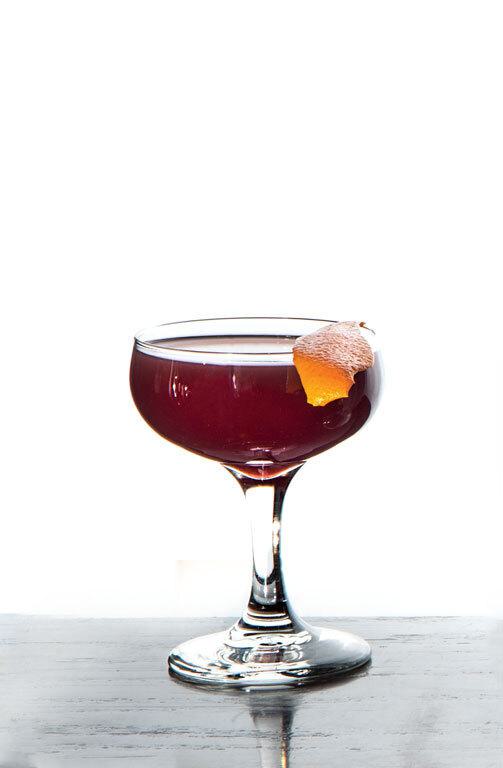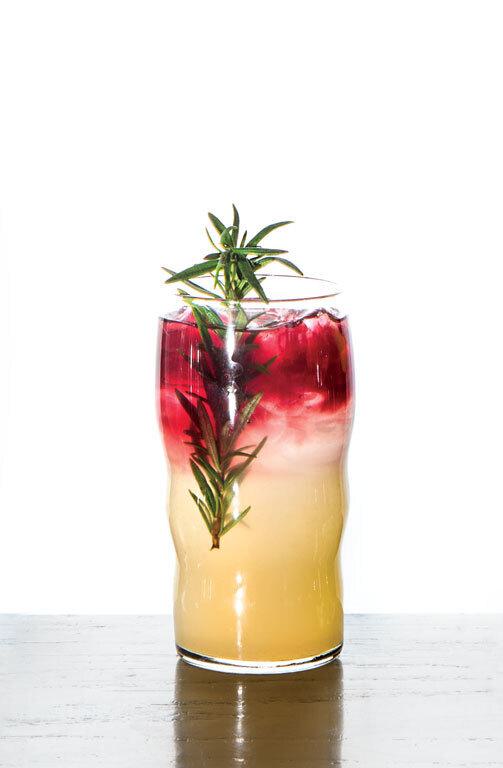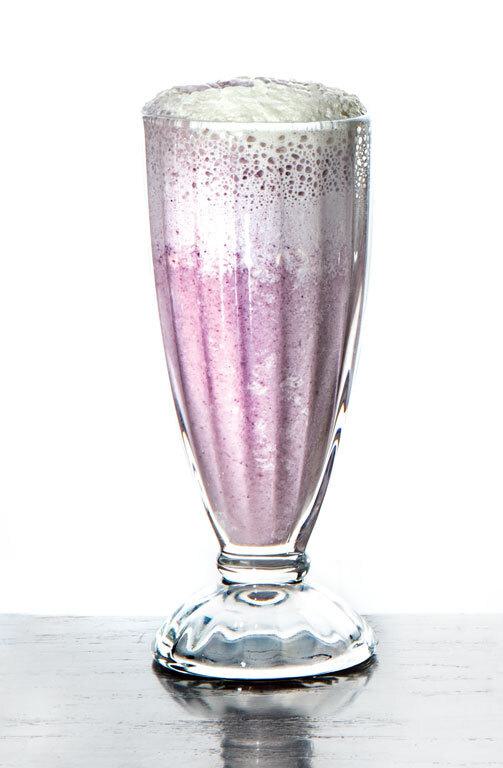- February 09, 2014
- By Liam Farrell
There was a time when the path of a drink Gina Chersevani served was simple. It started and ended in a tub full of other light beers at Terrapin Station.
On a chilly morning last November, she began that same journey in a more sophisticated—and unlikely—locale: a Northwest D.C. tea shop.
“What’s a stronger version of English breakfast?” Chersevani ’99, ’00 asked two women behind the counter at Teaism. “I want something darker, but that kind of flavor.”
She ended up with Keemun and Ceylon (respectively described by Teaism as “bright, wirey, tippy” and “with a slight smokiness and notes of sugar cane and red wine”), two flavors to combine into homemade syrup for the cocktails she has become famous for in the nation’s capital.
Chersevani is D.C.’s “Mixtress,” an award-winning mixologist who has captivated the city’s cocktail scene since concocting a cucumber cosmopolitan a decade ago during the “Sex and the City” craze. (When The Washington Post wrote last March, “Ask anyone who cares about what slips over their lips to list the leaders of the pack,” “Gina” was No. 3.)
Now the owner of The Eddy Bar inside Hank’s Oyster Bar restaurant at Capitol Hill and the Buffalo & Bergen soda shop at Union Market, Chersevani has aided and been aided by a nightlife evolution that has seen rounds of tequila shots turn into craft brews and 1930s-era drinks. With plenty of customers rejecting mass production and embracing the ethos of goods that are local, hip and unique, a cocktail can now begin in a Chinatown store that sells so many varieties of tea it is impossible to single out the smells.
It’s been quite a trip from college bars to working at the 2013 Preakness, where Chersevani oversaw the mixing of 30,080 hand-shaken cocktails in a single day.
Her success is an open rebuttal to the idea that she is “just a bartender.” Chersevani’s job requires an understanding of the science involved in combining ingredients to create something new, and the artistry to make it appeal to the eye and the palate. In a male-dominated arena, she is a rare female entrepreneur hoping to pave the way for other women.
“I definitely want to be an inspiration,” she says.
“A Hard Path”
Chersevani got an early education in mixing ingredients. She grew up outside New York City, where her father was a chef in a restaurant serving northern Italian food. Besides observing his work ethic, she got an introduction to his recipes.
Her mother (whose childhood address in Brooklyn provided the intersection name for Chersevani’s soda shop) would put out a dozen bottles and give her daughter directions on making salad dressing, stressing how each ingredient affected the others. Even today, the Mixtress says the best guide to creating a cocktail is famed chef Alice Waters’ “The Art of Simple Food.”
The quality of what Chersevani mixes has changed significantly since her days at Maryland. Back then, a signature concoction for her friends was a “Hop, Skip and Go Naked,” which involved an ice chest, cheap vodka, light beer and Country Time lemonade mix.
After graduating with bachelor’s degrees in fine art and psychology, Chersevani got a job at Penang in D.C. She had taken a bartending class, and a borrowed copy of “Difford’s Guide to Cocktails” helped spark an idea of how to lure in customers. Her next stop was at 15 Ria, a restaurant opened in 2003 by chef Jamie Leeds.
“I must have heard it a thousand times: ‘What are you doing?’ [Success] just starts to happen when you need it to.”
Chersevani, who says at the time she was a culinary “bull in a china shop,” credits Leeds with teaching her the value of proper technique, fresh ingredients and custom-made syrups.
“She was a fast learner,” says Leeds, who notes that muddling fruit was an early mixology lesson. “She’s incredibly creative. She’s always coming up with great ideas.”
Chersevani bounced to other restaurants in the area and learned different skills at each stop: how to grow your own ingredients at Poste Moderne Brasserie, the different uses of spices at Rasika, even how to incorporate fat and meat into cocktails at Tallula. (That’s not necessarily the oddest combination in her repertoire; she once demonstrated a drink involving milk and apple juice to a stunned cocktail class.)
The job-hopping would burn out a more corporate-minded person. But the restaurant industry has heavy turnover, and Chersevani says her ambition necessitated soaking up as much knowledge as she could from one venue and going to another before her skills became stale.
“It’s a hard path. That’s the nature of the beast,” she says.
Chersevani says it was also difficult to gain respect in the culinary world as a woman, and she tried to prove herself again and again in competitions, like when she won the Beacon Hotel’s Best Martini in D.C. contest in 2010.
What sustained her was the determination to be the best and the belief that what ultimately mattered was her own fulfillment.
“It puts a fire under you to be even better,” she says.
Reclaiming Quality
A parallel story runs alongside Chersevani’s journey to becoming a cocktail expert. That’s the creation of a demand for a cocktail expert.
For lack of a better word, the “hipsterization” of America clearly lent her a helping hand. The appeal of a more “authentic” lifestyle to 20- and 30-somethings has put a farmer’s market mentality—buy things with homegrown, boutique quality—into everything from beer to denim and furniture.
In this subculture, chain stores are acceptable only if they have maintained a cultural cachet (Japanese clothing company Uniqlo), are a guilty pleasure (Target) or have the closest supply of light bulbs (Wal-Mart). And these people don’t just live in Brooklyn or Portland, they live in Indianapolis, Houston and Washington, D.C.
“It’s changed dramatically,” Leeds says. “People are going out and enjoying the variety. Our clientele at Hank’s is a clientele who cares about what they eat and where it comes from.”
This ethos is visible in Chersevani’s businesses: the original 1930 soda counter from a Chicago Woolworth’s in Buffalo & Bergen, the clean white design of the Eddy Bar, the 1960s Airstream trailer she refurbished to sell frozen drinks during the summer in front of Union Market.
It’s more than nostalgia—it’s the reclamation of a less banal brand of quality. For the bagels at Buffalo & Bergen, Chersevani gets dough from New York because there was no other way to replicate her hometown’s taste. (“We tried. The water is just not the same.”)
At the Eddy Bar, Chersevani and her crew don’t buy packs of pre-cut ice cubes; rather, they buy it in blocks and break it into pieces themselves. Holding a frozen chunk in one hand and an ice tapper in the other, Chersevani talks about how a good bartender can break it without any shards flying away. It’s an art derived from the experience of analyzing the ice’s fissures and anticipating where it’s going to snap apart.
More importantly, properly broken ice produces a superior clarity. If done right, it makes the ice as transparent as the surrounding glass and liquid.
“As silly as it sounds, it makes really beautiful drinks,” she says.
By now, Chersevani is so familiar with each ingredient that goes into a cocktail—she calls the line of bottles behind the Eddy Bar her “spice rack”—that she can come up with new recipes without even tasting them. For a while, that has been a necessary skill, as she is pregnant with her first child, due in February.
She still surpasses 70 hours a week on her feet, but recognizes that her days of staying up late in bars are numbered. Chersevani is developing syrups and sodas that can be sold in stores like Whole Foods and Harris Teeter.
“I can’t be everywhere,” she says, “but retail can be.”
Though she relishes the opportunity to share her creations with a wider audience, she fears losing control over something she’s so passionate about.
“You created it, you love it, and you want to see it through,” she says. “If you are not afraid, then you are really doing something wrong.” TERP



